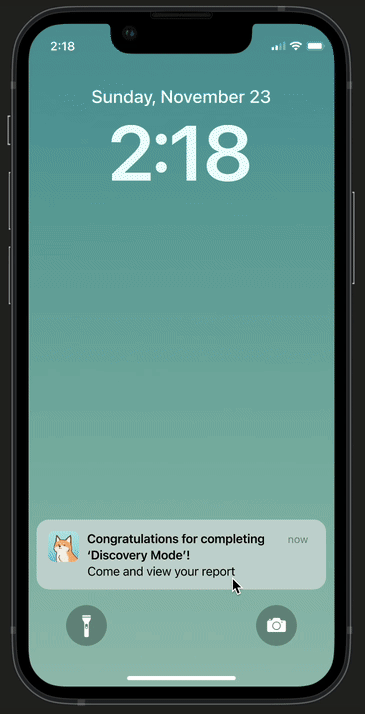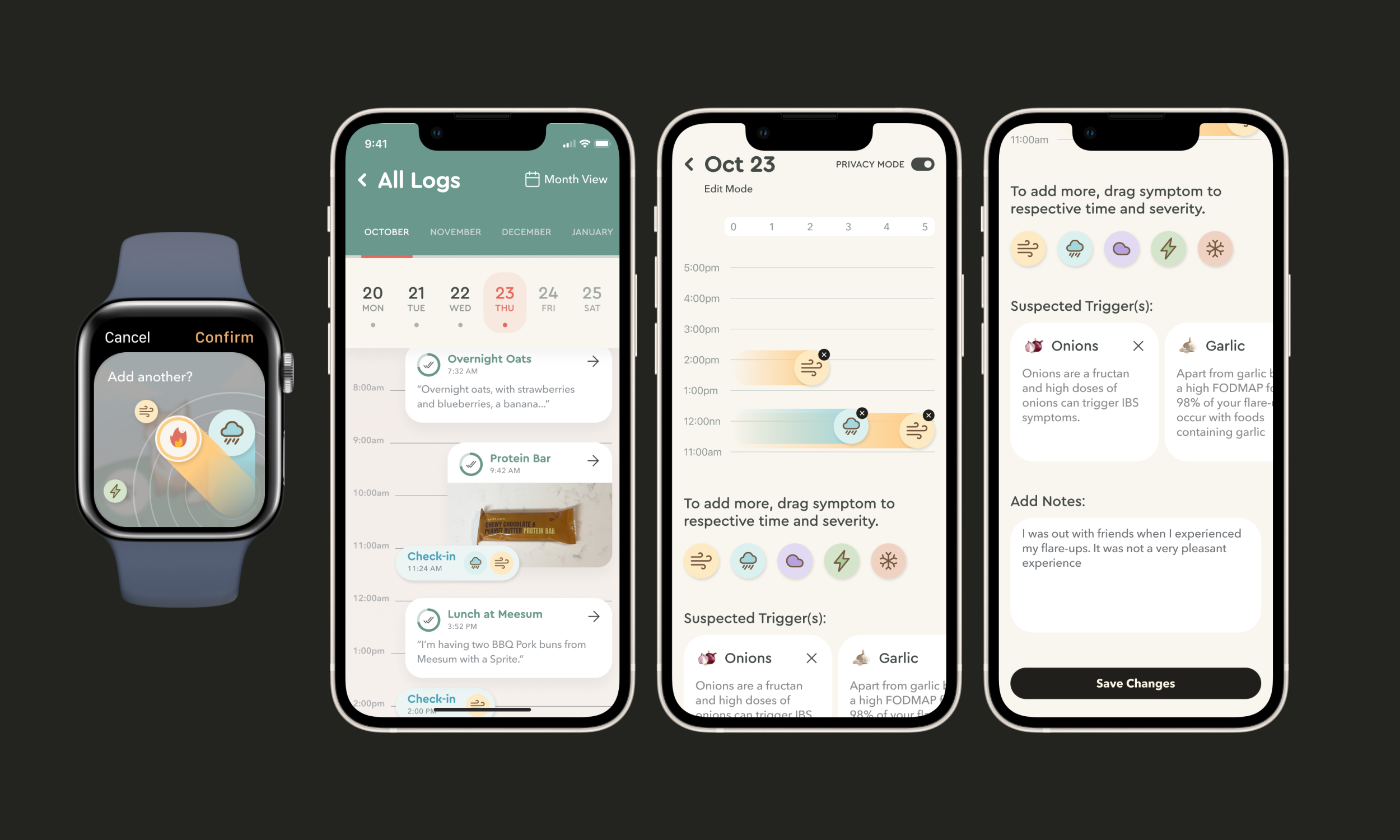
Fox Tracks, A Lifestyle Tool That Supports Individuals with FGIDs
Collaborators
2 Researchers
2 Designers
Role
Lead Product Designer
Duration
16 weeks
Company
MHCID+D Studio (Capstone)
Advised by Eric Lawrence from Intentional Futures
MY CONTRIBUTIONS
User Research
Assisted in the creation of our study plan and conducted 4 interviews.
Synthesis & Analysis
Collaborated with my team to analyze data and synthesize it into a user journey map
Wireframing
Oversaw all the wireframing effort for our team, including interaction details and IA.
Hi-Fidelity Prototype
Spearheaded UI design, animations, and design system with Mike.
PROBLEM SPACE
Among the 25 Million Americans that experience FGIDs, functional gastrointestinal disorders, 50% to 80% never consult a doctor and end up navigating their condition alone. FGIDs are characterized by persistent and recurring GI symptoms as a result of an abnormal functioning GI tract. The biggest problem is since symptoms and triggers vary wildly among individuals, each person must embark on a lifelong journey to identify their triggers and manage their symptoms. This lack of awareness about their digestive health, leads to poor decision-making and frequent flare-ups.
DESIGN APPROACH
An integrated Apple Watch and mobile tool that empowers individuals with FGIDs to make healthier lifestyle decisions
Foxy, their digestive support animal aims to help users become more aware of their digestive health by leveraging machine learning to surface timely, actionable and personalized insights. Since these insights are heavily reliant on digestive and biometric data, the tool also makes it easy to log triggers, flare-ups, sleep, and stress. Ultimately streamlining the process of identifying their triggers and managing their symptoms.
Track and log symptoms discretely
Using the Apple Watch, users can quickly swipe the intensity and type of symptom being experienced. Coded symbols are used to display symptoms.
Log food quickly and flexibly
Users have the option of logging food through audio, photo and timestamps. Then, edit them later on mobile.
Passively log biometric data
Research revealed that triggers are not just dietary but can result from stress and lack of sleep. Many Apple watches today are are able to track biomarkers like HRV for stress and quality of sleep
Discover Comprehensive Insights
By correlating symptoms with food logs and biometric data, Foxy is able to provide actionable digestive insights and recommendations.
Video editing and script by Michelle Thangtamsatid and Allison Ngo
RESEARCH
Understanding how Individuals with FGIDs Identify Their Triggers and Manage their Condition
Our Research Methodology:
20+ Scientific Journals
100+ Survey Participants
3 Types of Diary Enttries
2 rounds of thematic coding
10 Competitive Analyses
10 user interviews
1 round of affinitization
4 auto-ethnographic interviews
I Created A User Journey Map to Synthesize Information and Help The Team Identify Pain Points and Opportunities
CHALLENGE
How might we support individuals with FGIDs as they navigate their personal journey with digestive health?
IDEATION
Exploring community and individual approaches to the problem
I brainstormed 20 ideas out of the 80. I used methods such as crazy 8s, six thinking hats, mind mapping and free writing.
Notable Tools Used for Downselection
Grouping Similar Ideas
grouped similar ideas together helped us narrow down faster
Dot Voting Using Design Principles
Derived from research and user insights.
2X2 Matrix
We chose to focus on ideas on the community and and low user effort quadrant
Merged 4 Ideas Into One Journey
After realizing from design critiques that FGIDs are a very personal journey and should be approached individually, we chose to focus on the sustainable companion, TUMagotchi.
Part 1: Introduce
PR Campaign
Destigmatizes & normalizes FGIDs by increasing public exposure to the condition, leaning into openness & empowerment.
Part 2: Educate
Online Focus Group
Provides a safe space for users to engage in therapeutic anonymous discussion via online chat rooms.
Part 3: Experience
IRL Meetups
Builds in-person support network & creates accountability.
Part 4: Maintain
✅ TUMagotchi
Maintains learning and uses HP & QoL bars to help make decisions. Builds community support for flare-ups, & evolution to encourage self-discovery.
DESIGN
Used storyboarding to decide on the minimum viable product features
Our process:
Aligning on a specific user story
Lo-fidelity screens and interactions
Finalized Storyboard illustrated by Allison Ngo, and mid-fidelity screens by me
I designed the information architecture to break down the functionality of each device
We brainstormed how the Apple Watch and mobile app would work together to ensure a sustainable and seamless experience. This helped us clarify the roles of each device and determine the features and functionality.
Apple Watch Role: In-The-Moment Logging
Mobile App Role: Viewing Insights and Retroactive Logging
I identified the relationship between our mascot and our users
-
A mascot is a gentler and playful way to talk about a sensitive topic such as FGIDs. In our research, we learned that there’s still a large stigma surrounding FGIDs and some individuals don’t feel comfortable talking about it with others.
-
The mascot is similar to an emotional support animal. It provides emotional and educational support as you navigate the world of FGIDs. This support may come in the form of gentle nudges and recommendations when you need it the most. It also mirrors users symptoms
Below are some of the considerations we took when deciding on a mascot
Bun
Initially we decided on a rabbit. We decided on “Habit Rabbit” for a name, but ultimately decided against this because we felt it wasn’t the perfect match for our brand values.
Capybara
Initially we decided on a rabbit. We decided on “Habit Rabbit” for a name, but ultimately decided against this because we felt it wasn’t the perfect match for our brand values.
Milk and Onion
Milk and Onion are a cat and bird duo who were meant to represent the gut-brain connection. Ultimately, we thought the two representations would be hard for users to understand.
✅ Fox
We eventually chose a fox because of their intelligent, sensitive, proactive, and cheeky, personality making them the perfect digestive health support animal
Wireframing and exploring different interactions
We were two designers on the team so as to optimize workflow, I proposed that we divide the work. Below are some of the mid-fidelity interactions I worked on for the flare-up logging and discovery mode features.
FINAL DESIGN
Fox Tracks
We designed Fox Tracks, an integrated smartwatch & mobile experience that empowers individuals with FGIDs to make healthier lifestyle decisions for their digestive health.
Caters to Every Life Stage with Adaptive Modes
Managing FGIDs is a lifelong journey and Fox Tracks meets users where they are by giving them control over how they want to interact with the app. We recognize that users won't consistently log their dietary intake; instead, they are likely to only document flare-ups as they occur. We created two modes based on that mindset.
Design Principle: Sustainable Companionship
-
Low effort logging which consists of just logging flare-ups and passively logging biometrics such as quality of sleep and HRV, the golden standard for stress identification
-
Discovery mode is triggered either when an individual experiences frequent and intense flare-ups or when prompted by the user. This mode encourages users to actively log food and flare-ups as frequently as they can for a 3-week period. Once completed, users are given a comprehensive report about their digestive health.
Flexible and Easy Logging Experience
Fox Tracks allows both in-the-moment and retroactive flare-up logging, depending on the users needs. Logging in-the-moment is quick and easy while retroactive logging is more comprehensive.
Foxy gently keeps individuals accountable through dynamic visuals
Individuals with FGIDs face constant choices; even if they know their triggers, they may prioritize quality of life over dietary restrictions. Having a visual representation of their well-being nudges individuals to make healthier decisions for themselves. By using using coded weather symbols, Foxy is able discreetly reflect users' symptoms. Handling the topic of digestive health with care while also remaining light-hearted.
Design Principle: Be Gentle
A Holistic Approach That Considers Biometrics
Based on research, digestive health is not only affected by food, but by mental health as well. Fox Tracks integrates with Apple Health to collect biometric data such as sleep, heart rate variability (stress), and menstrual cycle. These can be passively tracked through the Apple Watch. These factors are analyzed to understand impacts on the user’s digestive health through correlation with symptom logs.
Design Principle: More Than Just A Diet
Gives individuals control over their own digestive health journey through digestive insights and comprehensive reports
By correlating symptoms with food log and biometric data, Fox Tracks provides personalized digestive insights and recommendations. Users can confirm or dismiss these based on how accurate they feel they are.
Design Principle: Autonomy
Learn with Weekly Educational Mail
Weekly Foxy Mail also shares educational tips about living with FGIDs. Users can use these to understand what works best for their body and build a healthy lifelong relationship with their gut.
DESIGN SYSTEM
Created comprehensive specs for key interactions
Next Steps
Crowdsource logging data
Make it even easier for users to log food by importing menu data and crowdsourcing items for other users to reference.Symptom management trials
Partner with businesses so users can easily test out different symptom management methods to see what works best for them.Foster community
Create a safe space for a community to form around Fox Tracks where users can support each other and share tips.Partner with restaurants
Collaborate with restaurants who have a list of Foxy approved safe meals or offer a barcode allowing users to scan for trigger ingredients on the menu.Expand to Android
Currently we’ve designed our experience for the Apple ecosystem. Next, we’d like to expand this to Android.
REFLECTIONS
What did I learn?
FGIDs are a big problem
The overwhelming amount of people who suffer from FGIDs surprised me, especially since they tend to do so in silence given that symptoms are embarrassing and can cause feelings of shame.Wide world of triggers
FGIDs manifest in a wide variety of symptoms that differ for each individual. I learned that things that seem like they would not be related, like sinus infections, can in fact be symptoms of FGIDs.Navigating sensitive topics
As we conducted interviews with participants, some reported substandard and occasionally hostile interactions with healthcare professionals. I learned how to navigate these conversations with empathy & compassion.Designing for an Apple Watch
I was surprised by the technical constraints of the Apple Watch, notably the clever industrial design creating the illusion of a larger screen which requires a #000000 header in order to avoid OS text visibly running to the edge of the screen.Prioritization
Designing a product can take years so having a short amount of time required our team to prioritize which features and user flows were essential for the minimum viable product.



















































